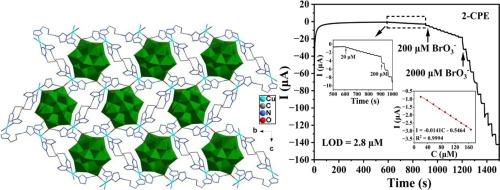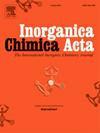Three metal–organic compounds based on [SiMo12O40]4-: Synthesis, structures and properties
IF 2.7
3区 化学
Q2 CHEMISTRY, INORGANIC & NUCLEAR
引用次数: 0
Abstract
Three polyoxometalate-based metal–organic complexes with the ability to treat pollutants in water were obtained under hydrothermal conditions using two flexible bis(triazole) organic ligands, [Cu(bte)2(H2O)]2[SiMo12O40]·2H2O (1), [Cu(btb)2]2[SiMo12O40]·H2O (2) and [Cu(btb)2(H2O)]2[SiMo12O40] (3) (bte = 1,2-bis(1,2,4-triazol-1-yl)ethane; btb = 1,4-bis(1,2,4-triazol-1-yl)butane). In compound 1, Cu2+ ions are linked by bte into a two-dimensional network layer with [SiMo12O40]4- anions filled between the layers as guest molecules. In compound 2, [SiMo12O40]4- anions act as four-connected ligands to coordinate with Cu2+ and fill in the pores of the three-dimensional framework constructed by Cu2+ and btb. In compound 3, [SiMo12O40]4- anions act as guest molecules to fill the channels of the two-dimensional layer formed by Cu2+ and btb. The electrochemical characteristics were studied, such as cyclic voltammetry, electrocatalytic reduction and oxidation of water contaminants, and current sensing of BrO3-. The photocatalytic degradation of organic dye pollutant MB (methylene blue) performance was also investigated under visible light conditions.

基于 [SiMo12O40]4- 的三种金属有机化合物:合成、结构和性质
利用两种灵活的双(三唑)有机配体,在水热条件下获得了三种具有处理水中污染物能力的聚氧化金属基金属有机配合物、[Cu(bte)2(H2O)]2[SiMo12O40]-2H2O(1)、[Cu(btb)2]2[SiMo12O40]-H2O(2)和[Cu(btb)2(H2O)]2[SiMo12O40](3)(bte = 1,2-双(1,2,4-三唑-1-基)乙烷;btb = 1,4-双(1,2,4-三唑-1-基)丁烷)。在化合物 1 中,Cu2+ 离子通过 bte 连接成二维网络层,[SiMo12O40]4- 阴离子作为客体分子填充在网络层之间。在化合物 2 中,[SiMo12O40]4- 阴离子作为四连接配体与 Cu2+ 配位,并填充在由 Cu2+ 和 btb 构建的三维框架的孔隙中。在化合物 3 中,[SiMo12O40]4- 阴离子作为客体分子填充了 Cu2+ 和 btb 形成的二维层的通道。对其电化学特性进行了研究,如循环伏安法、水污染物的电催化还原和氧化以及 BrO3- 的电流感应。此外,还研究了在可见光条件下光催化降解有机染料污染物 MB(亚甲基蓝)的性能。
本文章由计算机程序翻译,如有差异,请以英文原文为准。
求助全文
约1分钟内获得全文
求助全文
来源期刊

Inorganica Chimica Acta
化学-无机化学与核化学
CiteScore
6.00
自引率
3.60%
发文量
440
审稿时长
35 days
期刊介绍:
Inorganica Chimica Acta is an established international forum for all aspects of advanced Inorganic Chemistry. Original papers of high scientific level and interest are published in the form of Articles and Reviews.
Topics covered include:
• chemistry of the main group elements and the d- and f-block metals, including the synthesis, characterization and reactivity of coordination, organometallic, biomimetic, supramolecular coordination compounds, including associated computational studies;
• synthesis, physico-chemical properties, applications of molecule-based nano-scaled clusters and nanomaterials designed using the principles of coordination chemistry, as well as coordination polymers (CPs), metal-organic frameworks (MOFs), metal-organic polyhedra (MPOs);
• reaction mechanisms and physico-chemical investigations computational studies of metalloenzymes and their models;
• applications of inorganic compounds, metallodrugs and molecule-based materials.
Papers composed primarily of structural reports will typically not be considered for publication.
 求助内容:
求助内容: 应助结果提醒方式:
应助结果提醒方式:


